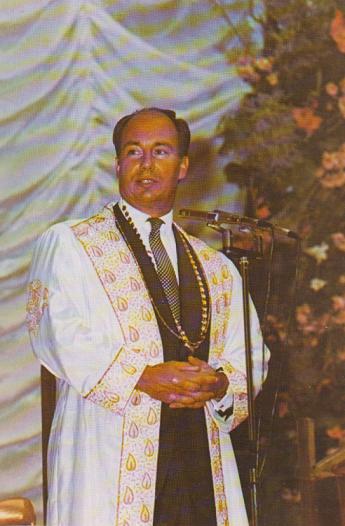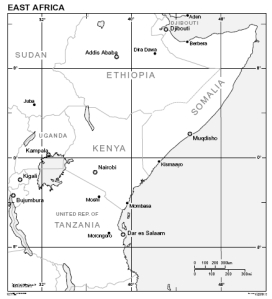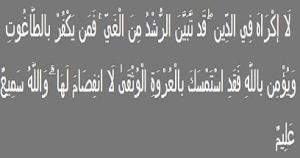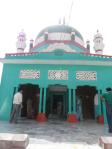SHORT ESSENTIAL READINGS
In Celebration of His Highness the Aga Khan’s Visit to East Africa

Mawlana Hazar Imam pictured at the Olympia Hall, London, during his weeklong visit to the United Kingdom Jamat in September 1979. Photo: Jehangir Merchant Collection.
ASPECTS OF THE ‘DIDAR’
Introduction: Ismaili followers (murids) throughout history have sought to articulate their experiences of the didar (lit. glimpse) of their Imam of the Time through ginans, qasidas, poetry and other narratives. Although the happiness and joy in beholding the face of Imam-e-Zaman is something which can only be felt and cannot be adequately described, their rich and vivid descriptions motivate us to seek out our own unique experiences in the ‘physical’ presence of Mawlana Hazar Imam. Thousands of Ismailis in East Africa will shortly have an opportunity to be in the blessed presence of Mawlana Hazar Imam. We can share in the Jamats’ joy and happiness as the murids await Mawla’s arrival.

An outline of East African countries. His Highness the Aga Khan will be visiting Kenya, Tanzania and Uganda in July 2011. Map Credit: United Nations
Simerg will endeavour to provide new posts about three times a week entitled “Essential Readings,” which we hope will contribute to making the mulaqat with Mawlana Shah Karim more meaningul and purposeful. In this regard, everyone’s understanding of the concept of Imamat is of paramount importance. What does Ismaili and related Shia literature reveal about the doctrine of Imamat? What are the pre-requisites in our daily lives to maximize the benefits from the didar of the Imam of the Time? What should our attitudes be in the presence of Mawlana Hazar Imam? These are some of the themes which “Essential Readings” will cover through short excerpts, which will include a supplication from a ginan, qasida or an individual poem. We therefore invite viewers from around the world to visit the Web site frequently and make use of this valuable resource, and share this momentous occasion for the East African Jamat. We also welcome contributions from our world-wide audience in the form of personal reflections, narratives and poetry relevant to the didar. Please submit your pieces to Simerg@aol.com with appropriate references.
1. The Imam – Proof of God The Holy Qur'an: Chapter 2, Verse 256 The first ontological plan of the Divine Being is the plan of the essence – indescribable, inconceivable, beyond all intelligence, intuition, or thought; this is the plan of the Unknowable, of God in His vertiginous, unmanifested concealment. The other is the plan of Acts performed by the organs of God, the Imams, instruments capable of making known to the creatures what can be known of God; this is the plan of the manifest God; of the unknown aspiring to be known. It is also to support this sense that the Imam is described as being the “Proof of God” (hujjat Allah), the “Path of God” (sirat Allah), the “Threshold of God” (bab Allah), or described by such Qur’anic expressions as “the Supreme Sign” (al-ayat al-kubra, Qur’an 79:20), “the August Symbol” (al-mathal al a’la, Qur’an 16:60), “the Most Solid Handle” (al-‘urwat al-wuthqa, Quran 2:256 and 31:22). One might wonder whether in this division between Essence and Organ there is a transposition, on the divine level, of the omnipresent division of all reality into batin and zahir. The esoteric, the hidden aspect not manifested by God would thus become His essence, eternally inaccessible; His Organs, that is His exoteric, His revealed aspect, would be the Imam in his ontological sense including His historical manifestations, that is, the imams of all ages. Thus knowledge of the reality of the Imam is the equiavalent to knowledge of that which can be known of God. In the words of Imam al-Husayn b. ‘Aly: “God created His servants so that they might know Him, for when they know Him they worship Him and thus free themselves from the worship of anything that is not Him.” Someone then asked: “What is the knowledge of God?” “It is, for the people of each age, knowledge of the imam to whom they owe obeisance.” * * * |
 Mawlana Hazar Imam - the current 'bearer' of the Noor of Imamat |
2. DAZZLED BY THE LIGHT: AL-SHIRAZI’S ACCOUNT OF A DIDAR “I was taken near the place where from I saw the bright Light of the Prophethood. My eyes were dazzled by the Light. I shed tears of joy and felt as if I was looking at the face of the Prophet of Allah and of the Commander of the Faithful, Hazrat Ali. I prostrated myself before the one who is the fittest person to bow to. I wanted to say something, but I was awe-struck. I tried to speak but my tongue refused to move. People asked me to say what I wished to say. I could say nothing. The Imam said, ‘Leave him. Let his fear and awe subside’. After this, I rose. I took the holy hand of the Imam [Mustansir-billah], placed it on my eyes and on my chest and then kissed it. I left the place with immense joy.” * * * |
 A portrait of the 48th Ismaili Imam. |
3. UNITY ESSENTIAL FOR COMPANIONSHIP ON HIGH “All men, rich and poor, must aid one another materially and personally. This fraternity is absolute, and it comprises men of all colours and all races: black, white, yellow, tawny; all are the sons of Adam in the flesh and all carry in them spark of the Divine Light. Everyone should strive his best to see that this spark be not extinguished but rather developed to that full Companionship-on-High. “It is my hope that my spiritual children, the Ismailis, will, by example of their own higher enlightenment and co-operative movement amongst themselves set to the world an example of better fraternity and brotherhood which alone can free men from the fear and dangers of moral and mental discord which leads to disaster for all.” * * * |
 The Aga Khans |
4. THE PRINCIPLE UNITY OF IMAMAT To Ismailis who believe in the Holy Institution of Imamat, the Imam-e-Zaman, or the Imam of the Age, is the manifest representation and the visible symbol of the Divine Institution they know as Imamat. The sublime verities of religious experience, based on the holy scriptures, remain inscrutable and beyond human understanding unless visualised by symbolic representation. It is impossible for man to look back at a symbolism from a given symbol. But man can view the symbol in the light of, or in the background of, a symbolism. Viewed in this light each Imam presents to the world of his time that facet of the multi-faceted splendour the Ismailis call Imamat. All Ismaili philosophers have emphasised the principle of the Unity of Imamat under the superficial diversity exhibited by each Imam of the Time. It is in this sense that the Ismailis believe that Imam is the same irrespective of his own age or the time he lives in. The proverbial valour and exemplary statesmanship of Imam Mawla Murtaza Ali, the encyclopaedic erudition of Imam Ja’far as-Sadiq, the extraordinary intellectual brilliance of Imam al-Hakim bi Amrillah, the administrative ability of Imam Mustansir Billah (during the first half of his Khilafat), the political acumen of Imam Sultan Muhammad Shah (he defied geography and created history), the organizing genius of the present Imam, Shah Karim al-Husayni, are only some of the more spectacular characteristics exhibited by the Imam of the Time in accordance with the exigencies of the situations facing him. * * * |
 The mausoleum of Pir Hasan Kabirdin |
5. A SUPPLICATION BY PIR HASAN KABIRDIN Transliteration Eji, Aash Karine Ya Ali hun tere dar ubhi, Translation With hope I stand at Thy door, * * * |
Date ‘Essential Readings (I)’ posted: June 25, 2011
Updated: June 28, 2011 (with link to next post)
Next – please click Short Essential Readings (II)
~~~~~~~~~~~~~~~
References (numbers below correspond to each of the above numbered excerpts):
(1): Excerpt is from The Divine Guide in Early Shi’ism, by Mohammad Ali Amir-Moezzi, SUNY, 1994, page 45.
(2): An Encounter with the Imam of the Time (article on this Website). Also, Al-Shirazi by Mohamed Adra in Ilm Volume 10, Number 2, July 1986
(3): The Face of Imamat (article on this Website)
(4): The Imam of the Socio-Economic Revolution (article on this Website)
(5): Verse of Ginan by Pir Hasan Kabirdin, published in Ilm Supplement, Mawlana Hazar Imam and Begum Salimah’s 1976 Pakistan Visit.
A Note to Readers: Please click Home page for other recent posts and click What’s New for links to all articles published on this blog since March 2009. Subscribe to this Website via the box near the top right of this page.
We welcome feedback/letters from our readers. Please use the LEAVE A REPLY box which appears below. Your feedback may be edited for length and brevity, and is subject to moderation. We are unable to acknowledge unpublished letters.

Excellent!